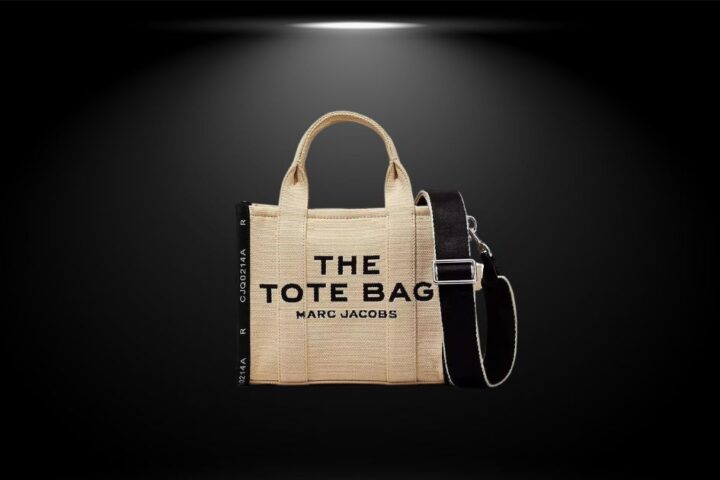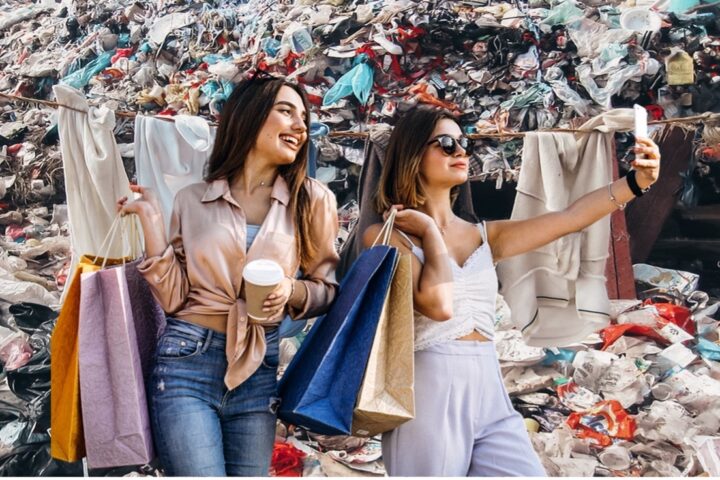Let’s start with the basics. After multiple data revealing the hard reality that fast fashion was a top contributor to Pollution, and Global Warming, it awakened consumers to the realities of the fast fashion industry.
This inevitably paved the way for people slowly shifting to sustainable fashion (I say slow because that’s how it is practically done). Sustainability in fashion can be achieved by a variety of ways. Even if you do not focus only on buying environment friendly clothing from a slow fashion brand with limited stock, which also tends to be expensive due to the greater gap in demand and supply, sustainability at its core is nothing but minimalism, and just reducing consumption and encouraging thrifting, is all viable ways to consciously shop, and limit the fast fashion craze.
But what this idea of being sustainable gave way to, was for fast fashion brands to find ways to continue sustaining the market. And the biggest trick off their sleeves is advertising. More precisely, false advertising.
And when this false advertising takes the shape of giving out false promises or statements, with respect to the environment, then the term for that is “Greenwashing”.
Greenwashing Campaigns:
These campaigns can take different roles, such as
– promising something that they can and do not keep,
– making vague statements that may or may not be true, and is open to interpretation, and
– no actual certifications to back up their claims, so they can very well be half-baked tales.
For how cruel such false claims sound, using the Environment like a scape-goat to gain nothing but a Marketing advantage, Greenwashing Campaigns are more common than you think.
A few popular examples in recent times are:
- H&M’s Looop Campaign – if there is one thing we know for sure about the brand, is that it is a leader at Fast Fashion and is anything but eco-friendly. They produce about 3 Billion articles of clothing in a year[1], and they are all made in such a way that they are soon discarded, and the company also introduces a new collection every season, with a great amount of their stock going to waste subsequently. 60% of their sustainability claims were called out to be misleading, but the Changing Markets Foundation.
As a marketing strategy, they introduced a campaign, partnering with Game of Thrones’ actor Maisee Williams as their Sustainability Ambassador, and created an advertisement that promises products to only be made by using recycled materials by 2030[2]. The brand has been called out for this attempt as the idea behind it is to just use a few recycled items in the process and call themselves sustainable due to the same.
And the company has had other instances of being called for Greenwashing as well. The other such Campaign is their Conscious Collection[3]. It is filled with vague promises, no proper, outright data or explanation given to how the same has been carried out[4], and it also strikes a question in your head, on, why have a sustainability collection, with vague promises and statements, and incomplete disclosures, but also have your fast fashion chain just flourish more than ever, and how by having this sustainability chain on the side inevitably only adds to the stock that reduce it in any way. It is like a pity party for people who want to purchase H&M but they are too guilt-prone to do it, so they pay a little extra for clothing that is possibly a tad-bit more sustainable than the rest.
- Mango’s Committed Collection: something on similar lines of the H&M’s Conscious Collection. Their idea is to sell a limited collection of clothing that promises sustainability, and they do have some international certifications to go with it. What they do promise eventually, is recycled cotton fabric, organic cotton (which is still water intensive and a monoculture crop), recycled polyester (recently proven to shed microfibres of plastic into our oceans when washed) and Tencel. Now this could not be much ground breaking, and is not as sustainable as promised. But the natural dies is a reasonable step, which they claim to also be used in 44% of their regular collections as well. [5] But what is astounding, is the false and vague promises, and for being called out previously on workplace endangerment in factories (identified to be one of the few brands that were sourcing products from the Rana Plaza factories in Bangladesh) and was one such brand which did not extend any support or provide compensation to the victims. The brand has also been called out for being one of the “worst things that has ever happened to the industry” and is simply based on the “sell fast, sell lots and damn the consequences” principle.
- SHEIN appointing a Head of Sustainability [ESG Officer] – while other fast fashion giants have at least made half-baked promises, Shein, a brand given extremely poor sustainability ratings, will be required to take a multitude of tangible steps, to convince consumers that they care, and this is not going to be enough. [6]
- Zara’s efficient stores – yet another example of how, targeting a very miniature portion of their business, exploit it a little less than before, and you can now label yourself to be a sustainable brand, is done. With them being a fast fashion brand, they have taken no tangible steps to reduce their production and textile wastage, no evidence to support their claims have been discovered yet either. [7][8] Although the list is restricted to the more relevant and well known fast fashion giants who continue to proudly exploit the environment with false labels of sustainability attached to them. It is pertinent to be understood that fast fashion is ingrained in the entire business structure and strategy of these brands. For them to be sustainable will mean they would have to change everything, and start afresh. And as long as they don’t do that, they are not sustainable, and nor should they fool consumers to believe so either.
REGULATING GREENWASHING CAMPAIGNS:
Multiple jurisdictions across the globe have realised the impact of greenwashing on the consumer market, and have hence taken significant steps to curb the same.
In the United Kingdom, the FCA has introduced steps towards mandating SDR [Sustainability Disclosure Requirements] disclosures, to ensure further transparency, in addition to the existing TCFD [Task Force of Climate- related Disclosures] aligned disclosure regime. The deadline for the first set of the same is set to be on June 23, 2022. They are also taking steps to ensure whether companies’ ESG statements are actually being translated into reality. [9]
Moreover, in September 2021, the Competition and Markets Authority (CMA) published its Green Claims Code (Code) and accompanying guidance, to shed light to businesses on guidelines to comply with their responsibilities towards the environment.
In Canada, The Competition Act, The Trademarks Act, the Canadian Code of Advertising Standards, etc., do play their parts in prohibiting false advertising and unfair trade practices.
In Singapore, the Consumer Protection (Fair Trading) Act (CPFTA) strides to protect consumers against unfair trade practices, ‘The Misrepresentation Act’ allows consumers to seek remedy against sellers providing false information, ‘The Singapore Code of Advertising Practice’ provides guidelines to businesses on fair advertising, and ‘The Monetary Authority of Singapore’ (MAS) that undertakes stress tests to identify and regulate the way banks handle climate risks tied to their borrowers, etc. among others.
What is special about regulations in France[10], is with respect to the existence of ‘The Climate and Resilience Law’, that quite specifically deals with trade practices of businesses against the Climate, and deals with regulating advertisements and prohibiting misrepresentation and misleading practices. [11]
If producing fast fashion is ignorant, greenwashing is outright cruel. It deems necessary that proper safeguards are put in place to ensure that people are not misled, and issues like Environment and Climate Change are not used as mere marketing tools, but are rather taken seriously and acted upon with genuinity.
REFERENCES:
- Nate Storey: “Can Prolific Polluter H&M Solve Fashion’s Waste Problem?”, Surface Mag, (Jan 29, 2021) https://www.surfacemag.com/articles/hm-green-machine-recycling/#:~:text=H%26M%20is%20one%20of%20the,clothes%20as%20recently%20as%202019.
- H&M: “RECYCLING SYSTEM ’LOOOP’ HELPS H&M TRANSFORM UNWANTED GARMENTS INTO NEW FASHION FAVOURITES” (Oct 7, 2020) https://about.hm.com/news/general-news-2020/recycling-system–looop–helps-h-m-transform-unwanted-garments-i.html
- H&M’s sustainability disclosure for the Conscious Collection, https://hmgroup.com/sustainability/
- Langa: “5 Earth Day Fashion Campaigns Which Are Actually Just Greenwashing”, Popdust.com, (April 22nd, 2021) https://www.popdust.com/earth-day-greenwashing-2652663175.html
- Arwa Lodhi: “GREEN OR GREENWASH? MANGO COMMITTED COLLECTION”, Eluxe Magazine, (April 21st, 2017) https://eluxemagazine.com/fashion/great-news-or-greenwash-mango-committed-collection/
- “Shein’s sustainability Rating”, Good on you.eco, https://directory.goodonyou.eco/brand/shein?_ga=2.6471537.2117120178.1660981161-1653535483.1660981161&_gl=1*1w78c49*_ga*MTY1MzUzNTQ4My4xNjYwOTgxMTYx*_ga_TTB1J3Q9MN*MTY2MDk4MTE2MS4xLjAuMTY2MDk4MTE2MS42MC4wLjA.
- Maddie Dockrill: “How Ethical is Zara?”, Good On You.eco, (Jan 12th, 2022), https://goodonyou.eco/how-ethical-is-zara/
- Solene Rauturier: “Greenwashing Examples: 8 Notorious Fast Fashion Claims and Campaigns” good on you.eco, (Jan 21st, 2022), https://goodonyou.eco/greenwashing-examples/
- David Rundle: “Greenwashing – a new regulatory risk” Wilmerhale Wire, UK, (republished at Mondaq) (on April 14, 2022) https://www.wilmerhale.com/en/insights/blogs/WilmerHale-W-I-R-E-UK/20220414-greenwashing-a-new-regulatory-risk
- Apurbaa Dutta: “Greenwashing by Fast Fashion Brands: Are they really concerned about Environment?”, Fashion & Law Journal, (Sept 9, 2021) https://fashionlawjournal.com/greenwashing-by-fast-fashion-brands-are-they-really-concerned-about-environment/
- Gowling WLG: “Greenwashing: Exploring the risks of misleading environmental marketing in the UK, Canada, France and Singapore”, Lexology, (April 28, 2022), https://www.lexology.com/library/detail.aspx?g=e6ffe14f-afbe-4722-85d6-56c3e6f088ea#:~:text=False%2C%20misleading%2C%20overstated%20or%20unsubstantiated,of%20consumer%20protection%20and%20advertising.
Author: Sai Smriti










